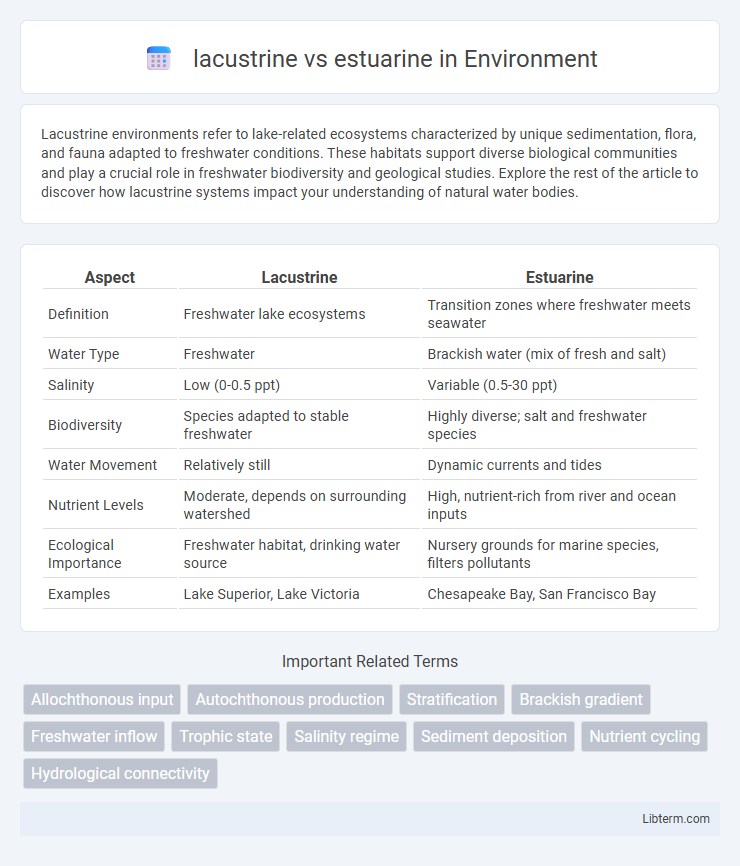Lacustrine environments refer to lake-related ecosystems characterized by unique sedimentation, flora, and fauna adapted to freshwater conditions. These habitats support diverse biological communities and play a crucial role in freshwater biodiversity and geological studies. Explore the rest of the article to discover how lacustrine systems impact your understanding of natural water bodies.
Table of Comparison
| Aspect | Lacustrine | Estuarine |
|---|---|---|
| Definition | Freshwater lake ecosystems | Transition zones where freshwater meets seawater |
| Water Type | Freshwater | Brackish water (mix of fresh and salt) |
| Salinity | Low (0-0.5 ppt) | Variable (0.5-30 ppt) |
| Biodiversity | Species adapted to stable freshwater | Highly diverse; salt and freshwater species |
| Water Movement | Relatively still | Dynamic currents and tides |
| Nutrient Levels | Moderate, depends on surrounding watershed | High, nutrient-rich from river and ocean inputs |
| Ecological Importance | Freshwater habitat, drinking water source | Nursery grounds for marine species, filters pollutants |
| Examples | Lake Superior, Lake Victoria | Chesapeake Bay, San Francisco Bay |
Introduction to Lacustrine and Estuarine Systems
Lacustrine systems are freshwater environments characterized by lakes and their sedimentary deposits, supporting diverse aquatic life adapted to stable, low-salinity conditions. Estuarine systems occur where freshwater rivers meet the ocean, creating brackish water zones with dynamic salinity gradients that influence unique sedimentation patterns and biological communities. Both systems play critical roles in nutrient cycling, habitat provision, and supporting fisheries, but their physical and chemical conditions differ significantly.
Defining Lacustrine Environments
Lacustrine environments are freshwater ecosystems found within lakes, characterized by standing water and limited tidal influence, supporting distinct sedimentary deposits and diverse biological communities adapted to stable conditions. These environments contrast with estuarine systems, which are coastal, brackish waters influenced by both riverine flow and marine tides, resulting in fluctuating salinity and dynamic habitats. Understanding lacustrine settings is crucial for interpreting sedimentation patterns, aquatic life adaptations, and water quality management in inland water bodies.
Characteristics of Estuarine Ecosystems
Estuarine ecosystems are characterized by their unique mix of freshwater and saltwater, creating a dynamic brackish environment with fluctuating salinity levels. These ecosystems support high biodiversity, including specialized plant species like mangroves and salt marsh grasses, and serve as critical habitats for fish nurseries and migratory birds. Nutrient-rich sediments and tidal influences enhance productivity, making estuaries vital for commercial fisheries and natural water filtration.
Hydrological Differences: Freshwater vs. Brackish Waters
Lacustrine environments consist primarily of freshwater systems found in lakes, characterized by low salinity and stable hydrological inputs dominated by precipitation and surface runoff. Estuarine environments transition between freshwater and marine waters, creating brackish conditions with variable salinity influenced by tidal mixing, river discharge, and seawater intrusion. The hydrological dynamics in estuaries result in fluctuating salinity gradients and complex water circulation patterns, contrasting with the more consistent freshwater conditions in lacustrine systems.
Biodiversity: Flora and Fauna Comparison
Lacustrine ecosystems, characterized by freshwater lakes, support diverse flora such as submerged macrophytes, phytoplankton, and riparian vegetation, hosting fauna including freshwater fish, amphibians, and invertebrates adapted to stable, oxygen-rich environments. Estuarine ecosystems, where freshwater mixes with seawater, feature salt-tolerant plants like mangroves and salt marsh grasses, while providing critical habitats for diverse fauna such as migratory fish species, crustaceans, and bird populations dependent on nutrient-rich brackish waters. Biodiversity in lacustrine systems thrives on freshwater species adapted to more stable salinity, while estuarine biodiversity features high productivity and species adapted to fluctuating salinity and tidal influences.
Sediment Dynamics in Lakes and Estuaries
Sediment dynamics in lacustrine environments are primarily influenced by freshwater input, lake morphology, and seasonal stratification, leading to sediment settling and resuspension patterns that shape benthic habitats. Estuarine sediment dynamics are characterized by the complex interplay of freshwater inflow, tidal currents, and salinity gradients, resulting in sediment transport, deposition, and erosion processes that affect nutrient cycling and habitat stability. Both systems exhibit unique sedimentological processes that determine sediment distribution, grain size variation, and organic matter accumulation critical for ecosystem functioning.
Nutrient Cycling and Productivity
Lacustrine ecosystems exhibit nutrient cycling primarily through internal loading and sediment interactions, supporting moderate productivity driven by phosphorus and nitrogen availability. Estuarine environments experience dynamic nutrient fluxes influenced by tidal mixing, freshwater inflows, and saltwater intrusion, resulting in high productivity and enhanced biogeochemical cycling. The varying nutrient sources and transport mechanisms create distinct ecological functions and productivity patterns between lacustrine and estuarine systems.
Human Impact on Lacustrine and Estuarine Areas
Human activities such as urban development, agriculture, and industrial discharge substantially alter lacustrine and estuarine environments by introducing pollutants, nutrients, and sediment loads that disrupt aquatic ecosystems. In lacustrine areas, nutrient enrichment often leads to eutrophication, causing harmful algal blooms and oxygen depletion that threaten freshwater species. Estuarine zones face challenges from habitat fragmentation, overfishing, and salinity changes due to freshwater diversion, compromising biodiversity and ecosystem services crucial for coastal communities.
Ecological Services and Importance
Lacustrine ecosystems provide critical ecological services such as freshwater storage, habitat for diverse aquatic species, and nutrient cycling within inland water bodies. Estuarine environments serve as vital nurseries for marine fish species, act as natural buffers filtering pollutants, and support high biodiversity due to their unique salinity gradients. Both ecosystems contribute significantly to local fisheries, carbon sequestration, and water purification, underlining their importance in sustaining ecological balance and human economies.
Conclusion: Key Contrasts and Considerations
Lacustrine environments are freshwater systems typically found in lakes, characterized by stable salinity and sediment deposition patterns, while estuarine environments represent dynamic brackish water zones where freshwater mixes with seawater, causing fluctuating salinity and nutrient levels. These differences significantly influence biodiversity, sediment transport, and ecological processes, with lacustrine systems supporting species adapted to consistent conditions and estuaries hosting diverse, adaptable communities due to tidal influences. Understanding these contrasts is crucial for effective management of water quality, habitat conservation, and response to environmental changes in each ecosystem type.
lacustrine Infographic

 libterm.com
libterm.com